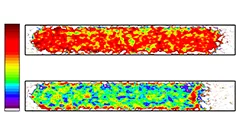The ability to start up at sub-zero Celsius temperatures is a prerequisite for the use of fuel cells in automotive applications, but specific measures need to be taken to prevent the product water to freeze and block the gas supply pathways. In this context, a method for imaging the distribution of liquid water and ice from neutron imaging experiments was developed. The differences in inelastic neutron scattering cross sections of ice and liquid water were used to distinguish between these two states in transmission imaging experiments. As the inelastic interactions become increasingly important for low energy neutrons, they are emphasized by using a Beryllium filter transmitting only the part of the neutron energy spectrum below 5.25 eV. To resolve the second unknown - the amount of water in each region of the cell - a second measurement is realized with the full energy spectrum. This “dual spectrum” imaging method has the advantage of a significantly increased flux compared to energy resolved imaging using monochromatic beams or velocity selectors. Although further work is necessary to make it an absolute detection method, dual spectrum neutron radiography was successfully applied in a small scale test cell to identify transitions of water from the super-cooled to the frozen state.


